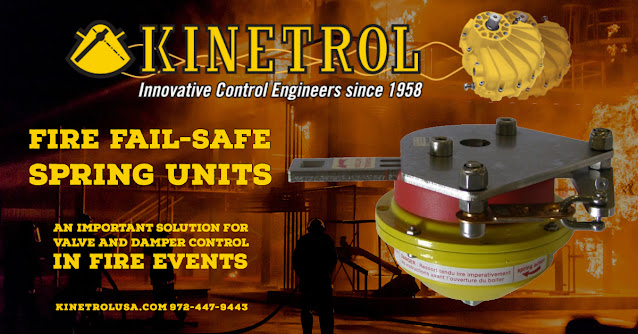Providing failsafe mechanisms for valves in industrial process control systems is critical for several reasons, particularly when considering fire safety.
The operation of a failsafe mechanism depends on the specifics of the process and the process media. A valve might need to fail-open (default to the open position when power is lost) or fail-closed (default to the closed position when power is lost), depending on the nature of the process and the potential hazards involved. For example, in a fire situation, a valve in a cooling water system might need to fail-open to ensure continuous cooling to prevent overheating. In contrast, a valve in a fuel line might need to be fail-closed to avoid the release of fuel that could feed the fire. So, the design of failsafe mechanisms must meet each industrial process's specific needs and hazards.
Kinetrol Fire Fail-Safe Spring Units are critical safety components in industrial systems, designed to ensure the automatic opening or closing of a valve or damper in the event of a fire. The inherent capability of these units to initiate a controlled response under fire conditions provides an extra layer of security to the process control landscape.
Central to the functioning of these fail-safe units is a fusible link mechanism. A fusible link is a device used in electrical, mechanical, or process control systems that acts as a failsafe mechanism. Its primary function is to fail or react when exposed to a specific temperature, often associated with fire conditions. They incorporate a material or a combination of materials (usually metal alloys) with low melting points. Under normal conditions, the fusible link will allow the system to function as designed. However, when the ambient temperature around the fusible link reaches a specific threshold (due to a fire or other abnormal condition), the material of the fusible link will melt or break. This action, in turn, triggers the Kinetrol Fire Fail-Safe Spring Unit into operation, and depending on the design and requirement of the system, the spring unit will open or close the valve or damper. The automatic movement restricts or allows the flow of fluids or gases, aiding in fire control by either isolating hazardous substances or allowing the passage of fire suppression agents.
Fusible links are a simple and effective way to add a layer of safety to systems where fire risk is present.
Overall, the Kinetrol Fire Fail-Safe Spring Units, through their incorporation of fusible link mechanisms, offer a reliable and effective method of mitigating the risks associated with fire in industrial environments.


